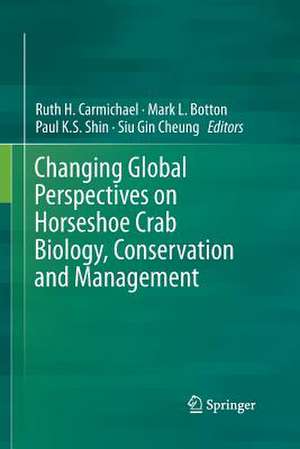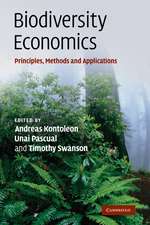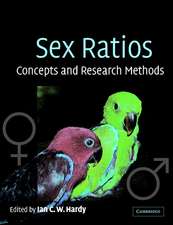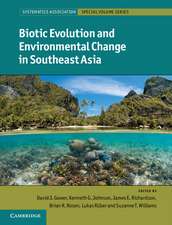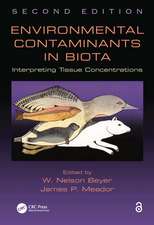Changing Global Perspectives on Horseshoe Crab Biology, Conservation and Management
Editat de Ruth H. Carmichael, Mark L. Botton, Paul K.S. Shin, Siu Gin Cheungen Limba Engleză Paperback – 22 aug 2016
| Toate formatele și edițiile | Preț | Express |
|---|---|---|
| Paperback (1) | 1233.06 lei 6-8 săpt. | |
| Springer International Publishing – 22 aug 2016 | 1233.06 lei 6-8 săpt. | |
| Hardback (1) | 1092.68 lei 38-44 zile | |
| Springer International Publishing – 16 noi 2015 | 1092.68 lei 38-44 zile |
Preț: 1233.06 lei
Preț vechi: 1503.73 lei
-18% Nou
Puncte Express: 1850
Preț estimativ în valută:
235.95€ • 246.97$ • 196.38£
235.95€ • 246.97$ • 196.38£
Carte tipărită la comandă
Livrare economică 31 martie-14 aprilie
Preluare comenzi: 021 569.72.76
Specificații
ISBN-13: 9783319360805
ISBN-10: 3319360809
Pagini: 599
Ilustrații: XXXVIII, 599 p.
Dimensiuni: 155 x 235 mm
Greutate: 0.89 kg
Ediția:Softcover reprint of the original 1st ed. 2015
Editura: Springer International Publishing
Colecția Springer
Locul publicării:Cham, Switzerland
ISBN-10: 3319360809
Pagini: 599
Ilustrații: XXXVIII, 599 p.
Dimensiuni: 155 x 235 mm
Greutate: 0.89 kg
Ediția:Softcover reprint of the original 1st ed. 2015
Editura: Springer International Publishing
Colecția Springer
Locul publicării:Cham, Switzerland
Cuprins
PART 1: EVOLUTION, ADAPTATION, AND GENTICS
1. The oldest species of the genus Limulus from the Late Jurassic of Poland
Błażej Błażejowski
2. The Delaware Bay area, USA: a unique habitat of the American horseshoe crab, Limulus polyphemus
CN Shuster, Jr.
3. Sea level rise in Delaware Bay, USA: Adaptations of spawning horseshoe crabs (L. polyphemus) to the glacial past, and the rapidly changing shoreline of the bay
RE Loveland, ML Botton
4. Conservation genetics of the American horseshoe crab (Limulus polyphemus): Allelic diversity, zones of genetic discontinuity, and regional differentiation
TL King, MS Eackles, AW Aunins, HJ Brockmann, E Hallerman, BB Brown
5. Florida, USA horseshoe crabs: Populations, genetics and the marine life harvest
HJ Brockmann, T Black, TL King
6. Genetic features of Tachypleus tridentatus in Japan and an alien (non-native) population founded at Ise-Mikawa Bay, Chubu Region, central Japan
S Nishida, K Kuroyanagi, H Koike
PART 2: ECOLOGY AND POPULATION DYNAMICS
7. Home range study of juvenile Chinese horseshoe crabs, Tachypleus tridentatus (Xiphosura), using passive tracking methods
BKY Kwan, PKS Shin, SG Cheung
8. Population structure and growth of juvenile horseshoe crabs T. tridentatus and Carcinoscorpius rotundicauda (Xiphosura) in southern China
MH Hu, BKY Kwan, Y Wang, SG Cheung, PKS Shin
9. Distribution and abundance of two sympatric species of horseshoe crabs along the Odisha Coast, India
S Behera, B Tripathy, K Sivakumar, BC Choudhury, P Bhadury
10. Studies of horseshoe crabs around Singapore
L Cartwright-Taylor
11. The population size and movement of horseshoe crab, Tachypleus gigas (Müller) on the East coast of Peninsular Malaysia
F Mohamad, N Ismail, A Bin Ahmad, A Manca, M Zul Fayyadh A Rahman, M Farhan S Bahri,
M Fawwaz Afham Mohd Sofa, I Huda Abdul Ghaffar, A Asyraf Alia’m, N Hafiz Abdullah, M
Mustakim Kasturi
12. Habitat inventory trend analysis of Limulus polyphemus populations on Long Island, USA: from the tip of Brooklyn to the tip of Montauk, 2003-2014
J Tanacredi, S Portilla
13. The life history cycle of Limulus polyphemus in the Great Bay Estuary, New Hampshire USA
H Cheng, C Chabot, W Watson
14. Molts reveal life-history patterns for juvenile American horseshoe crabs in fringe habitats
MG Estes, Jr, RH Carmichael, PDM Macdonald, AJ Brady, J McFadyen
PART 3: BIOLOGY AND PHYSIOLOGY
15. Preliminary investigation of effects of seawater pH on early development of Limulus polyphemus
J Tanacredi, S Portilla
16. Effects of sediment type and tank shape on horseshoe crab (Limulus polyphemus) growth and survival in culture
EE Hieb, JD Baggett, AM Aven, RH Carmichael
17. Bacteria and fungi identified on Horseshoe Crabs, Tachypleus gigas and Carcinoscorpius rotundicauda in the laboratory
MIM Faizul, HT Eng, A Christianus, YM Abdel-Hadi
18. Marine bacteria associated with horseshoe crabs, Tachypleus gigas and Carcinoscorpius rotundicauda
N Ismail, F Mohamad, A Ahmad, A Asyraf Alia’m, O Sheng Khai, M Fawwaz Afham Mohd Sofa, A Farid Manca
19. Mating tactics of the American horseshoe crab (Limulus polyphemus)
HJ Brockmann, SL Johnson, MD Smith, D Sasson
20. Examination of large exuviae with mating scars: Do female American horseshoe crabs,
L. polyphemus, molt after sexual maturity?
RH Carmichael, EE Hieb, G Gauvry CN Shuster, Jr
PART 4: CONSERVATION AND MANAGEMENT
21. Emerging issues in horseshoe crab conservation: A perspective from the IUCN species specialist group
ML Botton, RH Carmichael, PKS Shin, SG Cheung
22. Current status of Trachypleus tridentatus in Taiwan for Red List assessment
H Hsieh, C Chen
23. Status and threat perceptions of the Indian Horseshoe crabs along the Northeast coast of Bay of Bengal, India
JK Mishra, A Mishra, Yasmin
24. Assessment and management of North American horseshoe crab populations, with emphasis on a multispecies framework for Delaware Bay, USA populations
MJ Millard, JA Sweka, CP McGowan, DR Smith
25. The mismanagement of Limulus polyphemus in Long Island Sound, USA: What are the characteristics of a population in decline
M Beekey, J Mattei
26. Horseshoe crabs in modern day biotechnological applications
AP Das, B Bal, PS Mahapatra
27. Current horseshoe crab harvesting practices cannot support global demand for TAL/LAL. The pharmaceutical and medical device industries' role in the sustainability of horseshoe crabs
G Gauvry
28. Biomedical implications for managing the Limulus polyphemus harvest along the northeast coast of the United States
TJ Novitsky
29. Biotechnology efforts to conserve horseshoe crabs through the development of recombinant Factor C-based endotoxin test
P Li, B Ho, J L Ding
30. Development of aquaculture methods to enhance horseshoe crab populations: An example from Delaware Bay, USA
B Landau, D Jones, C Zarnoch, M Botton
31. Horseshoe crab research in urban estuaries: Challenges and opportunities
J Mattei, M Botton, M Beekey, C Colón
32. Green Eggs & Sand, Team Limulus and More: Educating for horseshoe crab conservation in the U.S.
G Kreamer, S T Kreamer
33. Building local community awareness of horseshoe crabs in Kujukushima, Nagasaki, Japan
C Nishimura, C Iwaoka
34. Young Voices: Through the Arts, Future Environmental Stewards Have a Global Voice
Glenn Gauvry, and Ruth H. Carmichael
1. The oldest species of the genus Limulus from the Late Jurassic of Poland
Błażej Błażejowski
2. The Delaware Bay area, USA: a unique habitat of the American horseshoe crab, Limulus polyphemus
CN Shuster, Jr.
3. Sea level rise in Delaware Bay, USA: Adaptations of spawning horseshoe crabs (L. polyphemus) to the glacial past, and the rapidly changing shoreline of the bay
RE Loveland, ML Botton
4. Conservation genetics of the American horseshoe crab (Limulus polyphemus): Allelic diversity, zones of genetic discontinuity, and regional differentiation
TL King, MS Eackles, AW Aunins, HJ Brockmann, E Hallerman, BB Brown
5. Florida, USA horseshoe crabs: Populations, genetics and the marine life harvest
HJ Brockmann, T Black, TL King
6. Genetic features of Tachypleus tridentatus in Japan and an alien (non-native) population founded at Ise-Mikawa Bay, Chubu Region, central Japan
S Nishida, K Kuroyanagi, H Koike
PART 2: ECOLOGY AND POPULATION DYNAMICS
7. Home range study of juvenile Chinese horseshoe crabs, Tachypleus tridentatus (Xiphosura), using passive tracking methods
BKY Kwan, PKS Shin, SG Cheung
8. Population structure and growth of juvenile horseshoe crabs T. tridentatus and Carcinoscorpius rotundicauda (Xiphosura) in southern China
MH Hu, BKY Kwan, Y Wang, SG Cheung, PKS Shin
9. Distribution and abundance of two sympatric species of horseshoe crabs along the Odisha Coast, India
S Behera, B Tripathy, K Sivakumar, BC Choudhury, P Bhadury
10. Studies of horseshoe crabs around Singapore
L Cartwright-Taylor
11. The population size and movement of horseshoe crab, Tachypleus gigas (Müller) on the East coast of Peninsular Malaysia
F Mohamad, N Ismail, A Bin Ahmad, A Manca, M Zul Fayyadh A Rahman, M Farhan S Bahri,
M Fawwaz Afham Mohd Sofa, I Huda Abdul Ghaffar, A Asyraf Alia’m, N Hafiz Abdullah, M
Mustakim Kasturi
12. Habitat inventory trend analysis of Limulus polyphemus populations on Long Island, USA: from the tip of Brooklyn to the tip of Montauk, 2003-2014
J Tanacredi, S Portilla
13. The life history cycle of Limulus polyphemus in the Great Bay Estuary, New Hampshire USA
H Cheng, C Chabot, W Watson
14. Molts reveal life-history patterns for juvenile American horseshoe crabs in fringe habitats
MG Estes, Jr, RH Carmichael, PDM Macdonald, AJ Brady, J McFadyen
PART 3: BIOLOGY AND PHYSIOLOGY
15. Preliminary investigation of effects of seawater pH on early development of Limulus polyphemus
J Tanacredi, S Portilla
16. Effects of sediment type and tank shape on horseshoe crab (Limulus polyphemus) growth and survival in culture
EE Hieb, JD Baggett, AM Aven, RH Carmichael
17. Bacteria and fungi identified on Horseshoe Crabs, Tachypleus gigas and Carcinoscorpius rotundicauda in the laboratory
MIM Faizul, HT Eng, A Christianus, YM Abdel-Hadi
18. Marine bacteria associated with horseshoe crabs, Tachypleus gigas and Carcinoscorpius rotundicauda
N Ismail, F Mohamad, A Ahmad, A Asyraf Alia’m, O Sheng Khai, M Fawwaz Afham Mohd Sofa, A Farid Manca
19. Mating tactics of the American horseshoe crab (Limulus polyphemus)
HJ Brockmann, SL Johnson, MD Smith, D Sasson
20. Examination of large exuviae with mating scars: Do female American horseshoe crabs,
L. polyphemus, molt after sexual maturity?
RH Carmichael, EE Hieb, G Gauvry CN Shuster, Jr
PART 4: CONSERVATION AND MANAGEMENT
21. Emerging issues in horseshoe crab conservation: A perspective from the IUCN species specialist group
ML Botton, RH Carmichael, PKS Shin, SG Cheung
22. Current status of Trachypleus tridentatus in Taiwan for Red List assessment
H Hsieh, C Chen
23. Status and threat perceptions of the Indian Horseshoe crabs along the Northeast coast of Bay of Bengal, India
JK Mishra, A Mishra, Yasmin
24. Assessment and management of North American horseshoe crab populations, with emphasis on a multispecies framework for Delaware Bay, USA populations
MJ Millard, JA Sweka, CP McGowan, DR Smith
25. The mismanagement of Limulus polyphemus in Long Island Sound, USA: What are the characteristics of a population in decline
M Beekey, J Mattei
26. Horseshoe crabs in modern day biotechnological applications
AP Das, B Bal, PS Mahapatra
27. Current horseshoe crab harvesting practices cannot support global demand for TAL/LAL. The pharmaceutical and medical device industries' role in the sustainability of horseshoe crabs
G Gauvry
28. Biomedical implications for managing the Limulus polyphemus harvest along the northeast coast of the United States
TJ Novitsky
29. Biotechnology efforts to conserve horseshoe crabs through the development of recombinant Factor C-based endotoxin test
P Li, B Ho, J L Ding
30. Development of aquaculture methods to enhance horseshoe crab populations: An example from Delaware Bay, USA
B Landau, D Jones, C Zarnoch, M Botton
31. Horseshoe crab research in urban estuaries: Challenges and opportunities
J Mattei, M Botton, M Beekey, C Colón
32. Green Eggs & Sand, Team Limulus and More: Educating for horseshoe crab conservation in the U.S.
G Kreamer, S T Kreamer
33. Building local community awareness of horseshoe crabs in Kujukushima, Nagasaki, Japan
C Nishimura, C Iwaoka
34. Young Voices: Through the Arts, Future Environmental Stewards Have a Global Voice
Glenn Gauvry, and Ruth H. Carmichael
Textul de pe ultima copertă
This book reports significant progress of scientific research on horseshoe crabs, including aspects of evolution, genetics, ecology, population dynamics, general biology and physiology, within the recent 10 years. It also highlights the emerging issues related to world-wide conservation threats, status and needs. The contributions in this book represent part of an ongoing global effort to increase data and concept sharing to support basic research and advance conservation for horseshoe crabs.
Caracteristici
Provides up-to-date research on horseshoe crab evolution, genetics, physiology, ecology, conservation and laboratory culture
Offers scientists students, conservationists and resource managers an integrated approach to the ecology and conservation of American and Asian populations of horseshoe crabs
Includes balanced contributions on the assessment of conservation threats, status and needs on conservation and management
Maximizes reader insight into a balanced perspective, including equal emphasis on primary research and conservation topics for both American and Asian species
Offers scientists students, conservationists and resource managers an integrated approach to the ecology and conservation of American and Asian populations of horseshoe crabs
Includes balanced contributions on the assessment of conservation threats, status and needs on conservation and management
Maximizes reader insight into a balanced perspective, including equal emphasis on primary research and conservation topics for both American and Asian species
